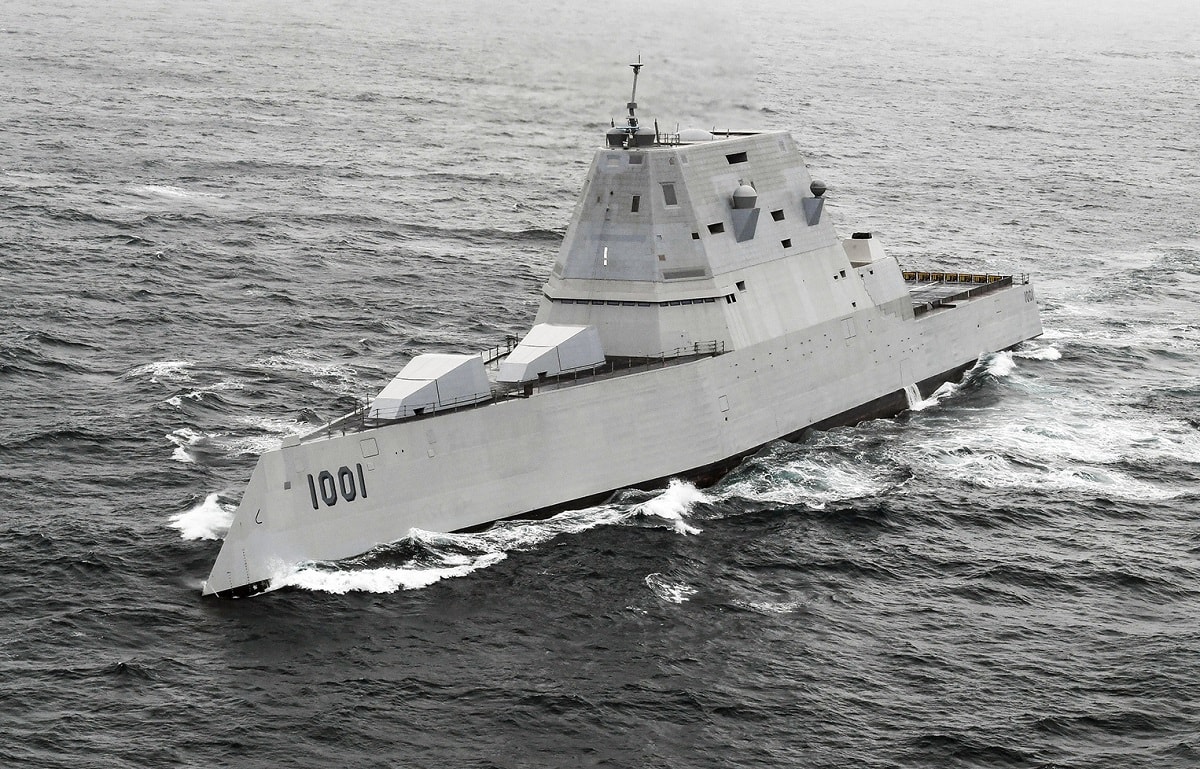USS Zumwalt Stealth Destroyer Already Showing Unseemly Age Marks: The U.S. Navy’s much-ballyhooed stealth USS Zumwalt destroyer looks like it has acne.
There are rust spots covering the ship and it doesn’t look healthy for a once-shiny new vessel. One 1945 analyst has noticed rust not just on the Zumwalt, but on other ships, particularly at Naval Station Norfolk, headquarters of the Atlantic fleet where at least three ships showed rusty spots. Is this a larger problem with maintenance in the navy or just a cost of doing business when conducting surface warfare patrols all over the world?
The Stealthiness of the Zumwalt-class
The USS Zumwalt is the lead vessel of two other Zumwalt-class advanced destroyers that have a distinct shape. The 610-foot Zumwalt-class ships have stealth characteristics from a small radar cross-section that is supposed to give the ships the ability to cruise closer to shore and fire their ordnance without being detected.
The Zumwalt-class ships have a unique look because of their tumblehome hull. This helps with the stealth features. The propulsion system is electric. The Zumwalt name was supposed to be synonymous with the highest levels of technology and the latest weaponry.
Other Modern Features Are Noteworthy
The all-electric ship has dual-band radar. One networked computing system handles all functions on the ship. Two sonar arrays are housed in the hull are designed to help the ship excel at undersea warfare. The MK57 Vertical Launching System handles the missile firing.
Not Smooth Sailing
But the acquisition life cycle has been rocky.
In 2016, the USS Zumwalt had to be towed out of the Panama Canal because it ran aground and its props quit. The navy originally wanted to buy twelve, but the program’s cost ballooned, and it was afflicted with delays. Only three exist. The Zumwalts’ total cost has been estimated at $14 billion.
There are other problems. The hull could become unstable in heavy seas, and it could be detected with low-frequency radar. To keep the radar evasion maximized, the close-in weapon systems were not equipped, and this is dangerous when it comes to defending appropriately against an enemy inbound anti-ship missile.

210421-N-FC670-1062 PACIFIC OCEAN (April 21, 2021) Zumwalt-class guided-missile destroyer USS Michael Monsoor (DDG 1001) participates in U.S. Pacific Fleet’s Unmanned Systems Integrated Battle Problem (UxS IBP) 21, April 21. UxS IBP 21 integrates manned and unmanned capabilities into challenging operational scenarios to generate warfighting advantages. (U.S. Navy photo by Chief Mass Communication Specialist Shannon Renfroe)
Expensive Munitions
Other armaments have been controversial. The Zumwalt was supposed to come with two 155mm Advanced Gun Systems. These use precision-guided shells that have a range of 60 miles. This would help prep an area for the marines to conduct amphibious operations.
But the Long Range Land Attack Projectile, a precision-guided munition, costs a whopping $800,000 per round. This is just too high a cost to be used. Even training missions would set the navy back too much. The Department of Defense doesn’t know how to replace it.
The USS Michael Monsoor, another Zumwalt-class ship, is performing various training off the west coast of North America, while the USS Lyndon B. Johnson is conducting builder’s trials.
The Rust Is Embarrassing
Now, about that rust.
USS Zumwalt (DDG 1000) Zumwalt-class guided missile destroyer coming into San Diego – December 9, 2021 #usszumwalt #ddg1000
* photos courtesy of @cjr1321 pic.twitter.com/cdolINeBZZ
— WarshipCam (@WarshipCam) December 10, 2021
This is a problem that shows neglect and even could symbolize larger difficulties with the U.S. Navy’s maintenance procedures.
It reminds me of the “broken window” theory of crime-fighting. If police officers ignore minor problems like broken windows in abandoned buildings and they walk past vandalism like nothing is wrong, it can lead to bigger incidences of crime down the road. The lesson here is not to ignore early deficiencies without doing anything about them.
Yes, the Navy has a high operational tempo and must do stressful deployments, especially in East Asia, where a mistake or miscalculation could cause the captain of the ship to be relieved immediately.
So, what is the problem? Is it maintenance budgets? If that is the case, Congress needs to take a tour of these installations and form their own opinions on what to do. The Secretary of the Navy needs to see these photos of rusty ships. If the leadership is not going to come from the active duty uniformed navy, then it needs to come from the civilian side.
What if Covid is hurting naval readiness and there are not enough sailors to remove the rust spots with corrosion control? This question should also be addressed by Congress and the Office of the Secretary of the Navy too.
Our competitors can spot trouble. Rust spots are embarrassing, and China and Russia are likely looking on with amusement knowing the U.S. Navy can’t take of what would seem to be basic maintenance.
To be fair, the navy has answered with their side of the story in this article from the Drive.com. “For the Surface Force, preservation is a constant battle against corrosion. The harsh environment in which we operate degrades our ships, and our sailors work hard to address corrosion along with all the maintenance and crew training required to sustain our Navy’s warfighting readiness.”
Now serving as 1945’s Defense and National Security Editor, Brent M. Eastwood, PhD, is the author of Humans, Machines, and Data: Future Trends in Warfare. He is an Emerging Threats expert and former U.S. Army Infantry officer. You can follow him on Twitter @BMEastwood.

